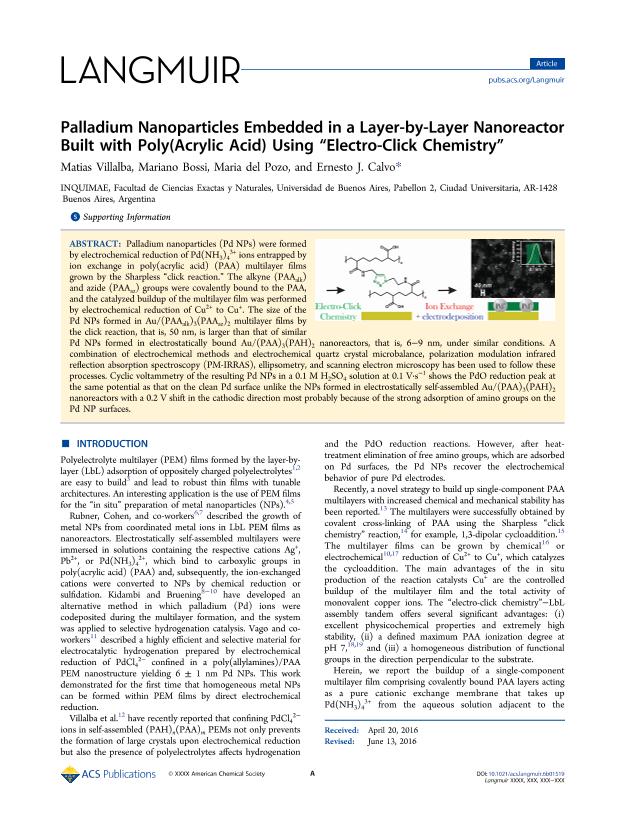Artículo
Palladium Nanoparticles Embedded in a Layer-by-Layer Nanoreactor Built with Poly(Acrylic Acid) Using "electro-Click Chemistry"
Fecha de publicación:
07/2016
Editorial:
American Chemical Society
Revista:
Langmuir
ISSN:
0743-7463
Idioma:
Inglés
Tipo de recurso:
Artículo publicado
Clasificación temática:
Resumen
Palladium nanoparticles (Pd NPs) were formed by electrochemical reduction of Pd(NH3)43+ ions entrapped by ion exchange in poly(acrylic acid) (PAA) multilayer films grown by the Sharpless "click reaction." The alkyne (PAAalk) and azide (PAAaz) groups were covalently bound to the PAA, and the catalyzed buildup of the multilayer film was performed by electrochemical reduction of Cu2+ to Cu+. The size of the Pd NPs formed in Au/(PAAalk)3(PAAaz)2 multilayer films by the click reaction, that is, 50 nm, is larger than that of similar Pd NPs formed in electrostatically bound Au/(PAA)3(PAH)2 nanoreactors, that is, 6-9 nm, under similar conditions. A combination of electrochemical methods and electrochemical quartz crystal microbalance, polarization modulation infrared reflection absorption spectroscopy (PM-IRRAS), ellipsometry, and scanning electron microscopy has been used to follow these processes. Cyclic voltammetry of the resulting Pd NPs in a 0.1 M H2SO4 solution at 0.1 V·s-1 shows the PdO reduction peak at the same potential as that on the clean Pd surface unlike the NPs formed in electrostatically self-assembled Au/(PAA)3(PAH)2 nanoreactors with a 0.2 V shift in the cathodic direction most probably because of the strong adsorption of amino groups on the Pd NP surfaces.
Palabras clave:
Palladium
,
Click Chemistry
,
Self-Assembled
,
Nanoparticles
Archivos asociados
Licencia
Identificadores
Colecciones
Articulos(INQUIMAE)
Articulos de INST.D/QUIM FIS D/L MATERIALES MEDIOAMB Y ENERGIA
Articulos de INST.D/QUIM FIS D/L MATERIALES MEDIOAMB Y ENERGIA
Citación
Villalba, Matias Ariel; Bossi, Mariano Luis; del Pozo, Maria; Calvo, Ernesto Julio; Palladium Nanoparticles Embedded in a Layer-by-Layer Nanoreactor Built with Poly(Acrylic Acid) Using "electro-Click Chemistry"; American Chemical Society; Langmuir; 32; 27; 7-2016; 6836-6842
Compartir
Altmétricas




